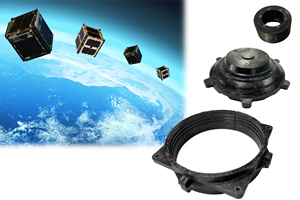Carbon fiber food tray arm: Better and cheaper
CW Conferences director Scott Stephenson summarizes the substance of a presentation at the High Performance Resins 2011 conference (Seot. 27-28) by Mohammad Moniruzzaman (SABIC Innovative Plastics, Pittsfield, Mass.), who detailed the development of a carbon fiber composite food tray arm for passenger aircraft seat backs.
Despite major gains enjoyed by carbon fiber composites in aerostructure applications on the Boeing 787 and the Airbus A350, there are still several metal-replacement opportunities that have the potential to help reduce the weight and improve the fuel efficiency of commercial aircraft. One such application was explored recently at CompositesWorld’s 2011 High-Performance Resins conference, held Sept. 27-28 in Cincinnati, Ohio.
The speaker was Mohammad Moniruzzaman, a product development engineer at SABIC Innovative Plastics (Pittsfield, Mass.). He detailed the development of a carbon fiber composite food tray arm (bottom, in photo), to replace conventional aluminum arms, on passenger seat backs. The composite part is made with SABIC’s LNP Thermocomp compound, which consists of Ultem polyetherimide (PEI) and either 30 or 40 percent (by weight) chopped carbon fiber.
On paper, such a replacement is promising. LNP Thermocomp EC006PXQ and EC008PXQ are 50 percent lighter than aluminum, have a tensile strength greater than die-cast aluminum and have a strength-to-weight ratio comparable to machined aluminum. Further, the stiffness-to-weight ratio of EC008PXQ is comparable to aluminum. And both materials have good flame, smoke and toxicity (FST) properties and are FAR 25.853-compliant. The challenge, reported Moniruzzaman, was designing the composite version of the food tray arm to cope with certain mechanical stresses imposed on the part.
The tray arm, as the name implies, is the structure that supports the food service tray for airline passengers. Each tray is held up by two arms; it folds down from the back of a seat and locks into a fixed position to provide a flat table surface. Each arm is about 10 inches/254 mm long and is angled in two places to accommodate the curvature of the passenger seat. The primary mechanical requirement of the arm is that it must maintain integrity after it is lowered to its level position. This is done with a small metal pin near the end of the arm where it attaches to the seat back, which prevents it from dropping the tray below level.
The carbon fiber arm that SABIC developed was injection molded, and Moniruzzaman said most of the design attention focused on the stress and structural integrity near the pin. Most importantly, SABIC discovered that the arm required additional support along the edge that contacts the pin. This led to a series of design adjustments to reinforce the entire end of the arm, including the addition of reinforcing ribs and the assessment of resin flow to make sure that material knit lines were not located in high-stress regions.
Moniruzzaman said the side support area on the arm originally measured 8 mm/0.3 inch, but it was increased to 20 mm/0.8 inch to meet the target load of 120 ft-lb. SABIC also found that closing the end of the arm increased the peak load/break load by 80 percent. The design also was modified to add a spider rib configuration, with multiple ribs radiating from the hole to the end of the arm.
Next, said Moniruzzaman, SABIC evaluated the injection-gate location (where the resin enters the mold) to optimize the melt-flow distribution and knit-line location. Of particular concern was crack formation, which was detected in early testing. A melt-flow analysis showed that when the injection gate was moved from the end of the arm to the side of the arm near its end, the knit line was shifted away from high-stress exposure, thus optimizing structural integrity. Final tests of the arm, with the spider rib configuration and using the side injection gate, demonstrated a peak load of 213 ft-lb, without cracking.
SABIC also evaluated carbon fiber loading and discovered that 40 percent loading provides good stiffness, low part deflection and good load-bearing capacity. A carbon fiber loading of 30 percent provided better load-bearing capacity but compromised stiffness and part deflection.
Of course, a composite part must perform as well in the field as it does in the test lab, and here SABIC showed the arm has real promise. The EC006PXQ arm weighs 0.1315 lb/0.0596 kg and the EC008PXQ arm weighs 0.1364 lb/0.0619 kg, slightly more than half the weight of an aluminum arm (0.2425 lb/0199 kg), at 0.2425 lb. For a fleet of 600 planes, Moniruzzaman contended, that translates, annually, into 500,000 gal in fuel savings and eliminates 9.9 million lb/4.5 million kg of carbon dioxide emissions.
The per-part cost savings is just as impressive. In lots of 10,000, aluminum 7075 is $1.00; Al 6061 is $0.85 and Al 380 (die cast) is $0.28. The composite EC008PXQ arm? A mere $0.23.
This design proves, once again, that carbon composites can best metal in both weight and cost, if the composite concept is designed for manufacture and not just as “black aluminum.”
Related Content
Plant tour: Albany Engineered Composites, Rochester, N.H., U.S.
Efficient, high-quality, well-controlled composites manufacturing at volume is the mantra for this 3D weaving specialist.
Read MorePlant tour: Airbus, Illescas, Spain
Airbus’ Illescas facility, featuring highly automated composites processes for the A350 lower wing cover and one-piece Section 19 fuselage barrels, works toward production ramp-ups and next-generation aircraft.
Read MoreNanopoxy, Nione jointly develop nanostructured epoxy resin
Epoxies featuring nanometric niobium pentoxide particles promote toughness, UV radiation resistance and other performance gains.
Read MoreComposite molding compound replaces Invar for lightweight small satellite structures
Patz Materials and Technologies and Lawrence Livermore National Laboratory developed a new monolithic optics housing with 80% less weight, near-zero CTE and the high-volume manufacturing required for commercial space.
Read MoreRead Next
VIDEO: High-rate composites production for aerospace
Westlake Epoxy’s process on display at CAMX 2024 reduces cycle time from hours to just 15 minutes.
Read MorePlant tour: A&P, Cincinnati, OH
A&P has made a name for itself as a braider, but the depth and breadth of its technical aptitude comes into sharp focus with a peek behind usually closed doors.
Read MoreModeling and characterization of crushable composite structures
How the predictive tool “CZone” is applied to simulate the axial crushing response of composites, providing valuable insights into their use for motorsport applications.
Read More
















.jpg;maxWidth=300;quality=90)







